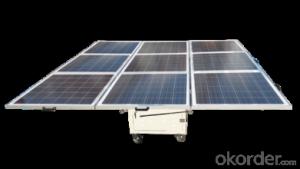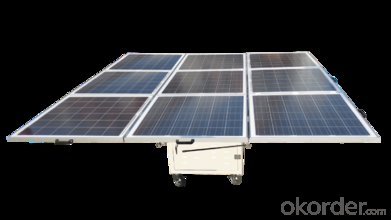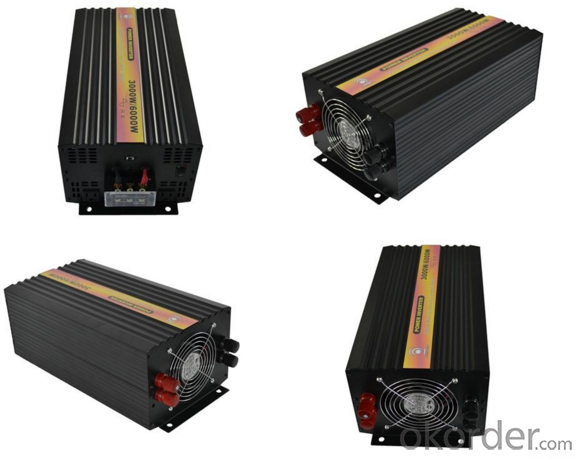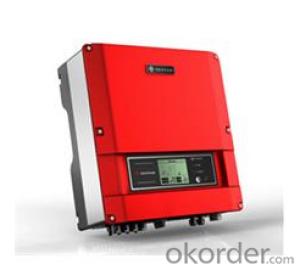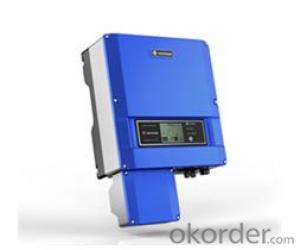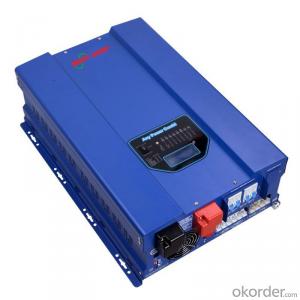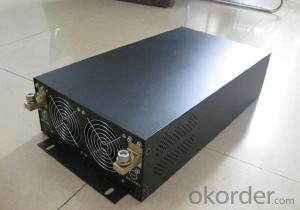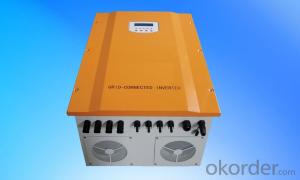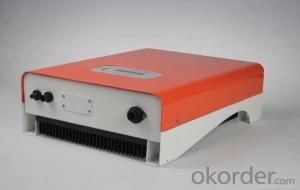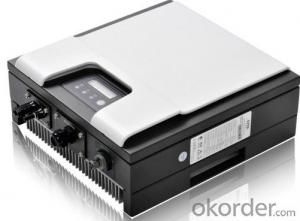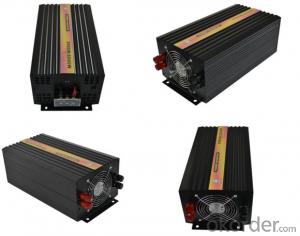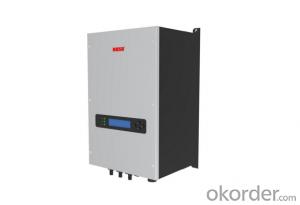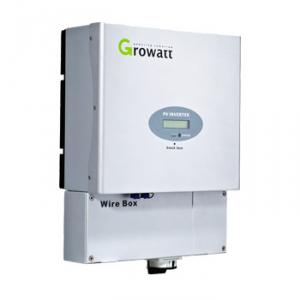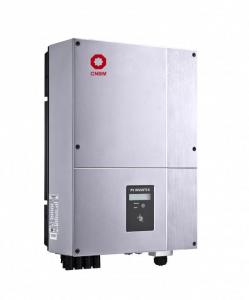MPPT Solar Inverter 48V - Single Phase Inverter Second Generation 3k Solar Inverter Made in China
- Loading Port:
- Shanghai
- Payment Terms:
- TT OR LC
- Min Order Qty:
- 0 watt
- Supply Capability:
- 10000 watt/month
OKorder Service Pledge
OKorder Financial Service
You Might Also Like
Description of Single Phase Inverter Second Generation 3k Solar Inverter
Solar ac power system consists of solar panels, charge controllers, inverter and battery; Solar energy does not include inverter dc power system. Inverter is a kind of power conversion device, inverter by incentives can be divided into self-excited oscillation inverter and separately excited oscillation inverter.
Features of Single Phase Inverter Second Generation 3k Solar Inverter
Standard 10 years warranty, 5-15 years optional
Built-in Gprs as option
Built-in Wifi as option
Smaller and lighter, only 9.6kg
High performance DSP for algorithm control
VDE-AR-N 4105 certification
New topology design
Dual MPPT design
Multi-button touch interface
LCD screen visible at night
Have anti-shading function
Advantages of Single Phase Inverter Second Generation 3k Solar Inverter
Longer life cycle
Plug and play
Free monitoring through our webportal
Very lower internal temperature
Easy transportation and installation
Faster CPU speed
Adjustable active and reactive power
Maximum conversion effciency up to 97.7%,Euro up to 96.9%
Real-time data readable at night
User friendly operation
Technical Data of Single Phase Inverter Second Generation 3k Solar Inverter
| Type | Omniksol-3k-TL2 |
| Input(DC) | |
| Max.PV Power | 3400W |
| Max,DC Voltage | 590V |
| Nominal DC Voltage | 360V |
| Operating MPPT Voltage Range | 120-550V |
| MPPT Voltage Range at Nominal Power | 150-500V |
| Start up DC Voltage | 150V |
| Turn off DC Voltage | 120V |
| Max, DC Current | 12A |
| Max, Short Cicuit Current for each MPPT | 16A |
| Number of MPP trackers | 2 |
| Max.Input Power for each MPPT | 2000W |
| Number of DC Connection for each MPPT | A:1/B:1 |
| DC Connection Type | MC4 connector |
| Output(AC) | |
| Max,AC Apparent Power | 3300VA |
| Nominal AC Power (cos phi = 1) | 3000W |
| Nominal Grid Voltage | 220V/230V/240V |
| Nominal Grid Frequency | 50Hz/60Hz |
| Max, AC Current | 14.4A |
| Grid Voltage Range** | 185-276V |
| Grid Frequency Range** | 45-55Hz/55-65Hz |
| Power Factor | 0.9 capacitive... 0.9 inductive |
| Total Harmonic Distortion(THD) | <2% |
| Feed in Starting Power | 30W |
| Night time Power Consumption | <1W |
| Standby Consumption | 6W |
| AC Connection Type | Plug-in connertor |
| Efficiency | |
| Max,Efficiency | 98.2% |
| Euro Efficiency | 97.3% |
| MPPT Efficiency | 99.9% |
| Safety and Protection | |
| DC Insulation Monitoring | Yes |
| DC Switch | Optional |
| Residual Current Monitoring Unit (RCMU) | Integrated |
| Grid Monitoring with Anti-islanding | Yes |
| Electricity Fuse Protection | Yes |
| Protection Class | Ⅰ(According to IEC 62103) |
| Overvoltage Category | PVⅡ/Mains Ⅲ(According to IEC 62109-1) |
| Reference Standard | |
| Safety Standard | EN 62109, AS/NZS 3100 |
| EMC Standard | EN 6100-6-1, EN 6100-6-2, EN 6100-6-3 EN 6100-6-4, EN 6100-3-2, EN 6100-3-3 |
| Grid Standard | VDE-AR-N4105. VDE-0126-1-1,G83/1,EN 50438,RD1699,CEI 0-21, AS4777,C10/C11 |
| Physical Structure | |
| Dimensions | 352x421x162.5mm |
| Weight | 16.5kg |
| Environmental Protection Rating | IP 65 (According to IEC 60529) |
| Cooling Concept | Internal fan convection |
| Mounting Information | Wall bracket |
| General Data | |
| Operating Temperature Range | -25℃ to +60℃(derating above 45℃) |
| Relative Humidity | 0% to 98%, no condensation |
| Max. Altitude (above sea level) | 2000m |
| Noise Type | <40dB |
| Isolation Type | Transformerless |
| Display | 3 LED ,Backlight, 4x20 Character LCD |
| Data Communication | RS485(WiFi, GRPS integrated) |
| Computer Communication | USB |
| Standard Warranty | 10 Years (5-15 years optional) |
IMages of Single Phase Inverter Second Generation 3k Solar Inverter
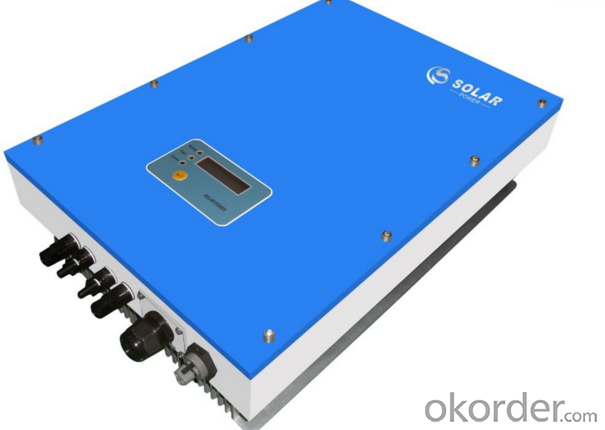
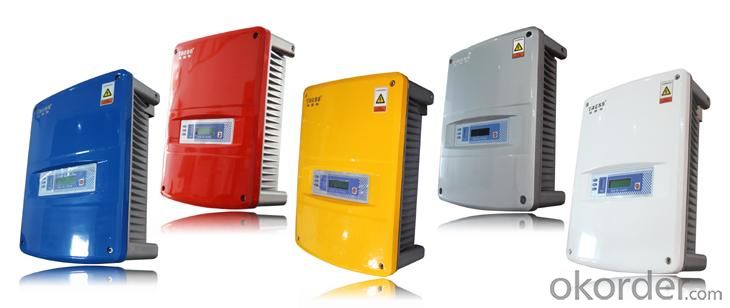
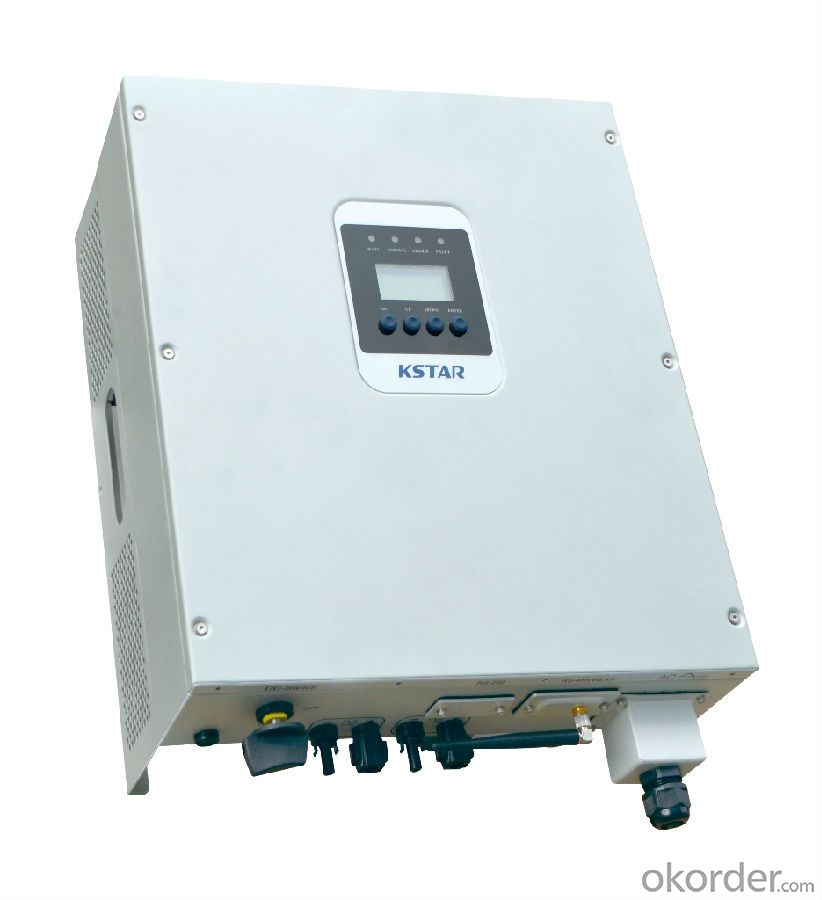
FAQ
Q: Do you have the CE, TUV, UL Certification?
A: We’ve already passed all the tests, and any certificate is available.
Q: Have you ever sold your products to companies in my country?
A: Of course, we have customers in all general PV markets, but I think we should expand our market share along with the market growth.
Q: When did your company set up? You are a new company, how can I believe your quality?
A: We entered into Solar PV industry in 2005, now we have several plants in manufacturing of a-Si and c-Si panels, and our capacity is 220MW per year. Till now we have already passed all the tests by authorized laboratories, e.g. TUV, CE, UL.
Q: Can you help us install the module if we cooperate with you?
A: We haven’t entered into installation sector, but we have the plan in near future.
Q: How do you pack your products?
A: We have rich experience on how to pack the panels to make sure the safety on shipment when it arrives at the destination.
Q: Can you do OEM for us?
A: Yes, we can.
Q: Can we visit your factory?
A: Surely, I will arrange the trip basing on your business schedule.
- Q: Can a solar inverter be used with a solar-powered air purification system?
- Yes, a solar inverter can be used with a solar-powered air purification system. A solar inverter converts the direct current (DC) generated by solar panels into usable alternating current (AC) electricity, which can power various appliances or devices, including air purification systems. By connecting a solar inverter to a solar-powered air purification system, it can efficiently operate using renewable energy from the sun.
- Q: How does a solar inverter handle varying solar irradiance levels?
- A solar inverter handles varying solar irradiance levels by continuously monitoring the incoming solar energy and adjusting its operations accordingly. It converts the direct current (DC) produced by solar panels into alternating current (AC) that can be used to power electrical devices. When the solar irradiance levels are high, the inverter optimizes the power output to match the maximum potential of the solar panels. Conversely, during low solar irradiance, the inverter adjusts its operations to ensure optimal efficiency and power generation. This adaptive nature of solar inverters allows them to efficiently harness solar energy under varying conditions.
- Q: How do you calculate the maximum power point current for a solar inverter?
- To calculate the maximum power point current for a solar inverter, you need to determine the optimal operating voltage and current at which the solar panel can produce the maximum power. This can be done by using a technique known as the perturb and observe (P&O) algorithm. The P&O algorithm continuously adjusts the operating point of the solar panel by slightly perturbing the voltage and observing the resulting change in power. By tracking the voltage and current values that yield the highest power output, you can calculate the maximum power point current for the solar inverter.
- Q: Can a solar inverter be used with a smart home automation system?
- Certainly! A smart home automation system can indeed work together with a solar inverter. Nowadays, many solar inverters come with communication capabilities built-in, like Wi-Fi or Ethernet connectivity. This means that they can easily be integrated into a smart home automation system. This integration allows homeowners to remotely monitor and control their solar power production and usage using a smartphone app or a central control panel. By having a smart home automation system, users can keep track of real-time energy generation, make adjustments to settings, and receive notifications about system performance or any potential issues. This integration not only enhances the convenience and efficiency of managing solar power but also enables better optimization and synchronization with other smart devices and appliances in the household.
- Q: What is the role of transformerless design in a solar inverter?
- The role of transformerless design in a solar inverter is to eliminate the need for a bulky and heavy transformer, resulting in a smaller, lighter, and more efficient inverter. By removing the transformer, the design reduces energy losses, improves power conversion efficiency, and lowers manufacturing and installation costs. Additionally, transformerless inverters allow for increased flexibility in system design and make it easier to integrate with other renewable energy sources and smart grid technology.
- Q: Can a solar inverter be used with solar-powered remote sensing systems?
- Yes, a solar inverter can be used with solar-powered remote sensing systems. A solar inverter is responsible for converting the direct current (DC) generated by solar panels into alternating current (AC) that can be used to power various devices and systems. In the case of solar-powered remote sensing systems, the solar inverter would be an essential component in converting the DC power from the solar panels into the required AC power to operate the remote sensing equipment.
- Q: Are solar inverters weatherproof?
- Yes, solar inverters are designed to be weatherproof. They are typically built to withstand various weather conditions such as rain, snow, and extreme temperatures. However, it is always recommended to consult the manufacturer's specifications and guidelines to ensure proper installation and protection against environmental factors.
- Q: How does a solar inverter handle different temperature conditions?
- A solar inverter is designed to handle different temperature conditions by incorporating various protective measures. It typically includes temperature sensors and cooling systems to monitor and regulate its internal temperature. Additionally, it may have heat sinks or fans to dissipate excess heat generated during operation. These features ensure that the inverter operates within its optimal temperature range, maximizing efficiency and protecting it from potential damage caused by extreme temperature variations.
- Q: What is the difference between a PV inverter and a solar inverter?
- The main component of the inverter is the three-phase bridge converter. The main purpose of the grid-connected inverter is to change the power to DC and change the AC power. The main purpose is to improve the power quality (because the wind power generation is very large
- Q: How does a solar inverter handle voltage rise in case of low load conditions?
- A solar inverter handles voltage rise in case of low load conditions by reducing the power output from the solar panels. It does this by adjusting the voltage and frequency of the electricity generated, ensuring that the voltage remains within the acceptable range. This prevents any damage to the inverter or connected devices and ensures the efficient operation of the solar system.
Send your message to us
MPPT Solar Inverter 48V - Single Phase Inverter Second Generation 3k Solar Inverter Made in China
- Loading Port:
- Shanghai
- Payment Terms:
- TT OR LC
- Min Order Qty:
- 0 watt
- Supply Capability:
- 10000 watt/month
OKorder Service Pledge
OKorder Financial Service
Similar products
Hot products
Hot Searches
Related keywords
